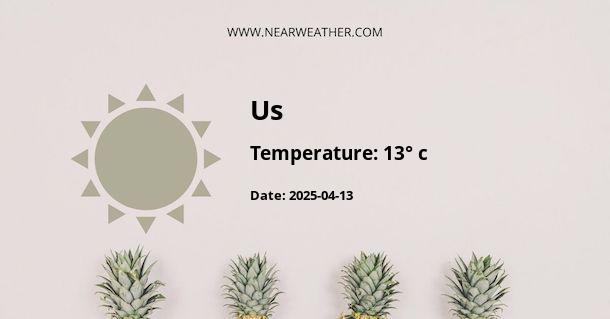Climate and Weather in the United States
The United States is a vast country with diverse geographical features, resulting in a wide range of climates and weather patterns. From the tropical climate of Florida to the arctic climate of Alaska, the United States offers a variety of weather conditions throughout the year.
1. Northeastern United States
The northeastern region of the United States experiences four distinct seasons. Summers are generally warm and humid, with temperatures ranging from 70°F to 90°F (21°C to 32°C). Winters are cold and snowy, with temperatures averaging between 20°F and 40°F (-6°C and 4°C). The region is also known for its beautiful fall foliage, as the leaves change color during the autumn months.
Major cities in the Northeast, such as New York City and Boston, experience moderate rainfall throughout the year, with the highest precipitation occurring during the summer months.
2. Southern United States
The southern region of the United States has a subtropical climate, characterized by hot and humid summers and mild winters. Summers can be extremely hot, with temperatures reaching up to 100°F (38°C) or higher. Winters are generally mild, with temperatures ranging between 40°F and 60°F (4°C and 15°C).
The southern states, including Florida and Louisiana, experience a high amount of rainfall, particularly during the summer months when tropical storms and hurricanes are more common.
3. Western United States
The western region of the United States is known for its diverse climate and weather patterns. The states in this region experience a wide range of temperatures and precipitation levels.
In the Pacific Northwest, including states like Washington and Oregon, the climate is mild and wet. Summers are generally cool, with temperatures ranging from 60°F to 80°F (15°C to 27°C), while winters are mild and rainy, with temperatures averaging between 40°F and 50°F (4°C and 10°C).
In contrast, the southwestern states, such as California, Arizona, and Nevada, have a Mediterranean climate, characterized by hot and dry summers and mild, wet winters. Summers in these states can be scorching, with temperatures often exceeding 100°F (38°C). Winters are mild, with temperatures ranging from 50°F to 70°F (10°C to 21°C).
4. Central United States
The central region of the United States, often referred to as the "Midwest," experiences a mix of continental and humid subtropical climates. Summers in the Midwest are generally hot and humid, with temperatures ranging from 80°F to 90°F (27°C to 32°C). Winters are cold, with temperatures averaging between 20°F and 30°F (-6°C and -1°C).
Tornadoes are more common in the central United States, particularly in an area known as Tornado Alley, which stretches from Texas to South Dakota. Spring and early summer are the peak seasons for tornado activity in this region.
Climate and Weather in France
France, located in Western Europe, has a temperate climate influenced by its proximity to the Atlantic Ocean and the Mediterranean Sea. The country experiences mild winters and warm summers, with regional variations in climate.
1. Northern France
Northern France has a maritime climate, characterized by mild temperatures and moderate rainfall throughout the year. Summers are generally mild, with temperatures ranging from 60°F to 75°F (15°C to 24°C). Winters are cool, with temperatures averaging between 40°F and 45°F (4°C and 7°C).
Paris, the capital city of France, falls in this region and experiences a similar climate. The city sees moderate rainfall, with the wettest months being May and June.
2. Southern France
Southern France has a Mediterranean climate, known for its hot and dry summers and mild, rainy winters. Summers in this region can be scorching, with temperatures often exceeding 90°F (32°C) and occasionally reaching over 100°F (38°C). Winters are mild, with temperatures ranging from 45°F to 55°F (7°C to 13°C).
Cities like Nice and Marseille are popular tourist destinations in Southern France, attracting visitors with their warm Mediterranean climate and beautiful coastal views.
3. Western France
Western France, including regions like Brittany and Normandy, experiences a maritime climate similar to Northern France. Summers are mild, with temperatures ranging from 60°F to 70°F (15°C to 21°C), while winters are cool, with temperatures averaging between 40°F and 45°F (4°C and 7°C).
The western coast of France is known for its picturesque landscapes and rugged coastline.
4. Eastern France
Eastern France has a continental climate, characterized by hot summers and cold winters. Summers are generally warm, with temperatures ranging from 70°F to 80°F (21°C to 27°C). Winters can be cold, with temperatures dropping below freezing, averaging between 20°F and 30°F (-6°C and -1°C).
Cities like Strasbourg and Lyon fall in this region and experience a mix of continental and maritime influences.
Overall, France offers a pleasant climate with regional variations that cater to different preferences, whether you prefer mild temperatures in the north or the hot summers of the Mediterranean coast.
A - Us's Latitude is 49.099998 & Longitude is 1.966670.
A - Weather in Us is 17° today.
A - Climate Conditions in Us shows clear sky today.
A - Humidity in Us is 55% today.
A - Wind speed in Us is 18.5 km/h, flowing at 140° wind direction. today.
